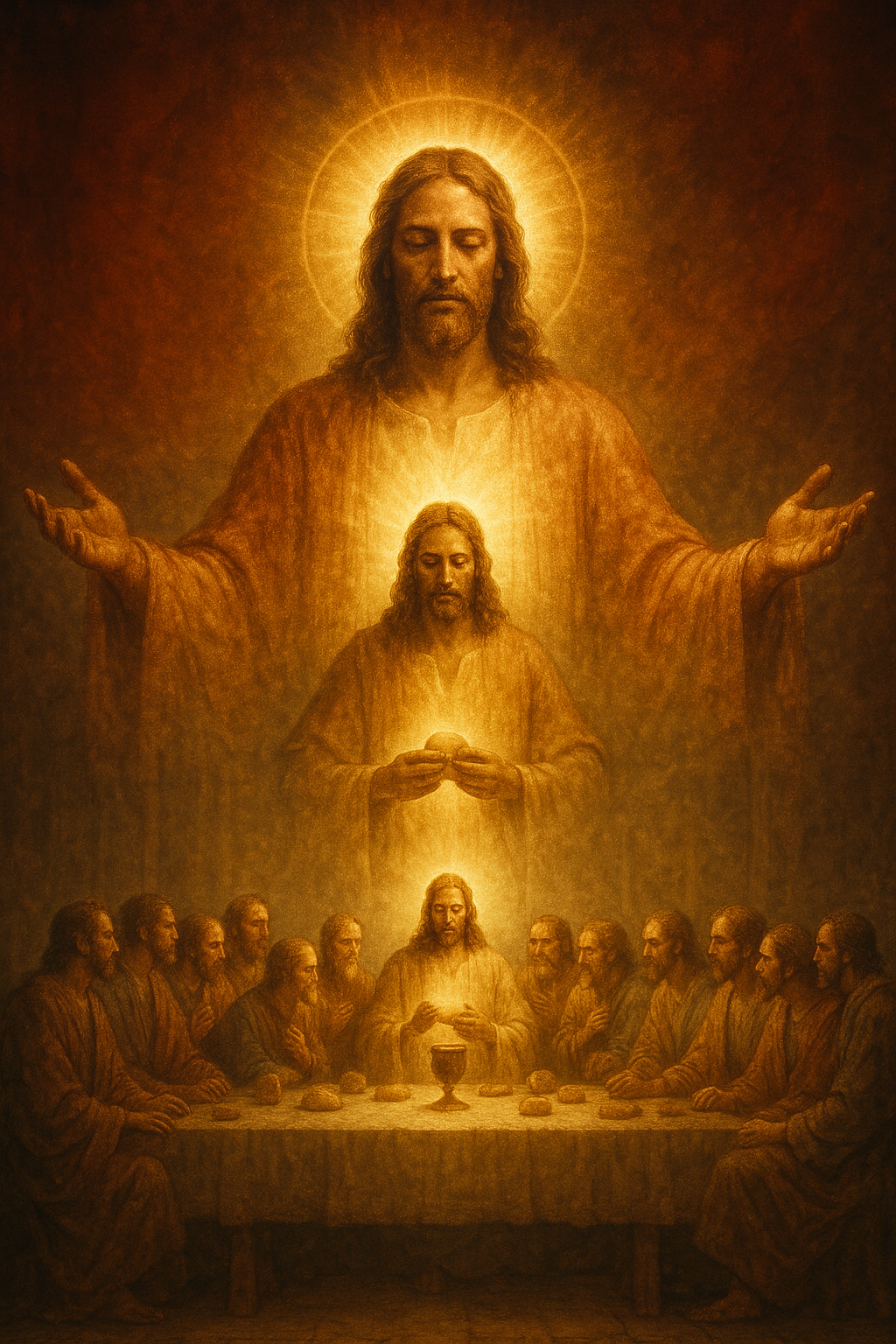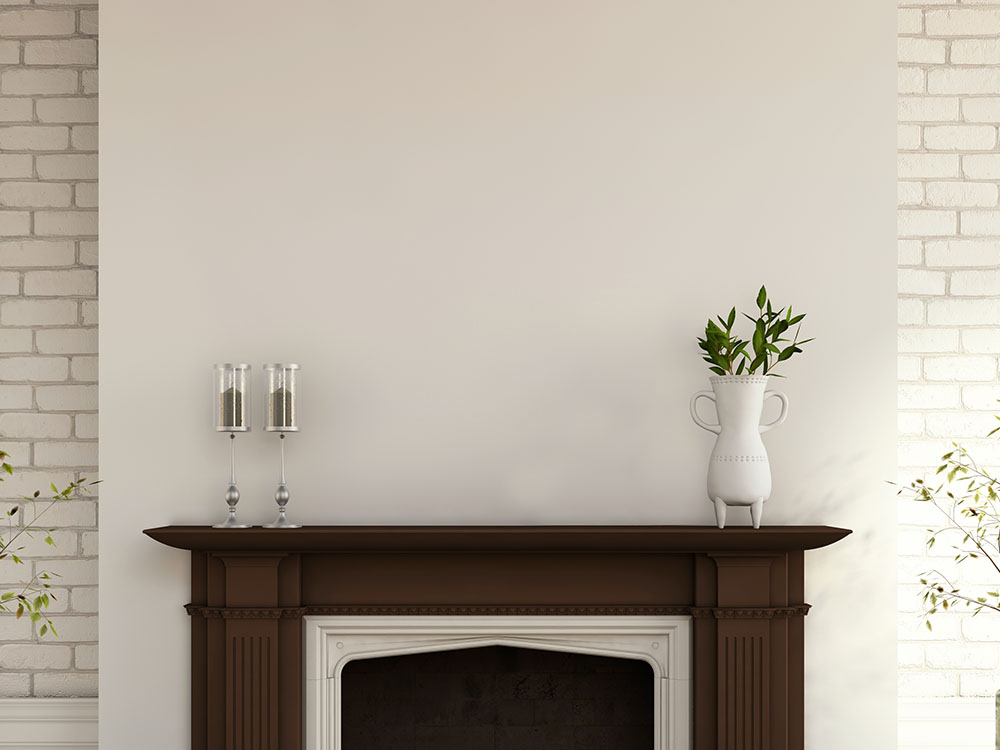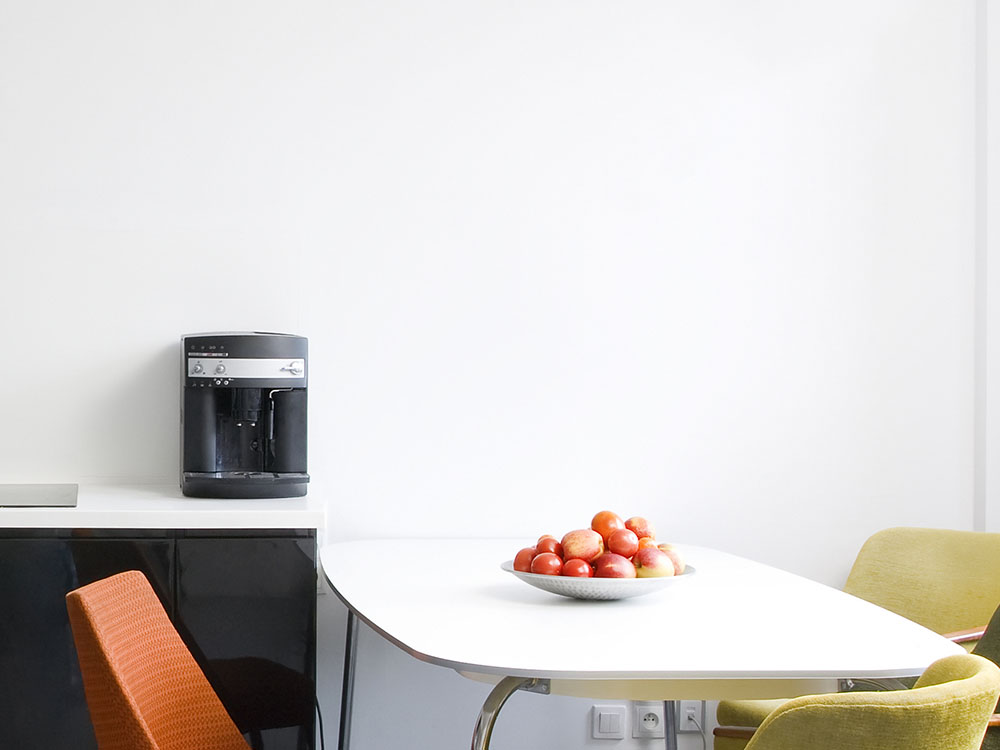Words About High Quality Canvas Art Print
🌟The Last Supper’s Golden Mystery Canvas Print: Christ Revealed🌟
At first glance the image feels familiar: Jesus sits at the center of a long table, bread broken before Him, chalice waiting. The apostles flank both sides, their faces turned inward in a mix of curiosity and concern. Yet something new emerges—above the seated Christ, a second and then a third, larger figure rises, each suffused with concentric halos of light. The scene reads like a theological staircase: earthly Jesus at the table, sacramental Jesus who offers His Body, and cosmic Christ whose outstretched arms hold the whole moment in mercy. This layered approach does more than amplify drama. It compresses time. We are seeing the Thursday night in Jerusalem, the centuries of Christian worship that follow, and the eternal embrace of God—all at once. The painting turns a single meal into a living altar, where history and heaven meet.Three ways the Canvas Print artwork shows who Christ is
1) The historical Christ. The lowest figure is the Jesus of the Gospels—calm, composed, entirely present to His friends. By placing Him at the table with ordinary bread and cups, the artist anchors the scene in daily life. Salvation starts at eye level.2) The sacramental Christ. The middle figure, hands poised over the bread, draws attention to the mystery of the Eucharist. The glow concentrates around the host, suggesting that grace is not a distant abstraction but a gift held and shared. The visual cue is unmistakable: what happens at this table continues in every communion where believers gather.
3) The cosmic Christ. The largest figure fills the frame, arms open wide. He is not separate from the others; He envelops them. Here the artist points to the Christ who is “before all things and in whom all things hold together.” The message is pastoral and bold: nothing—neither betrayal nor doubt nor suffering—falls outside His reach.
Gold as theology: why the color matters
The painting leans heavily on a golden palette. Gold, in sacred art, is more than a pretty hue. It stands for what does not fade—the uncreated light of God. Byzantine icons use gold backgrounds to signal that the scene takes place in God’s time, not ours. This work adapts that language. The warm glow pours over robes, faces, and hands, telling us that holiness doesn’t cancel the human world; it illumines it. Even shadows become gentle. The result is a mood of hope: amid tension and impending sorrow, a quiet radiance remains.Bread, chalice, and the center of gravity
Place your finger at the exact middle of the composition and you will likely touch the bread or the chalice. That is not accidental. The artist builds a visual theology of the Eucharist by giving the elements the scene’s center of gravity. The bread is ordinary—small loaves scatter the table—yet the one in Jesus’ hands receives the brightest light. The chalice sits steady, anchoring the lower edge like a small but immovable horizon. Together they preach that love is both humble and costly: broken to be shared, poured out to make others whole.The apostles: twelve mirrors of the heart
Look along the table and you’ll see twelve different ways of being human before God. One apostle leans in, eager; another hangs back, guarded. A few fold their hands in prayer; others clutch their robes as if caught between fear and longing. This variety is the point. The Last Supper is not a club of the spiritually elite. It is a gathering of real people—faithful, fickle, passionate, confused—whom Jesus still chooses to feed. In pastoral settings, this image can help viewers find themselves at the table: there is a seat for the zealous and the hesitant alike.Composition that teaches while it moves your eyes
Good sacred art catechizes without a single word. Here, the artist uses a vertical axis to teach. Your eyes travel upward from table to host to the embracing figure above, then downward through the same line to the chalice. This motion traces the logic of Christian worship: the Son comes from the Father to us, and we are lifted—with bread and wine, with our lives—back to God. The rhythm is gentle, almost liturgical; it invites meditation more than debate.A bridge between icon and Renaissance
Art history whispers throughout the piece. The pyramid-like stacking of figures recalls the compositional clarity prized by Renaissance masters; the golden atmosphere nods to the timeless space of icons. Unlike Leonardo’s complex stagecraft, this painting avoids architectural drama. There is no room receding into perspective, no clusters breaking into sharp argument. Instead we are offered a stillness that speaks. The effect is contemplative and contemporary at once—an image that would feel at home in a church, a gallery, or a quiet corner where someone is learning to pray.Pray with the image: a simple visio divina
If you want to go beyond admiration to encounter, try this brief practice:- Look. Sit with the image for one minute. Let your gaze rest on the bread, then the chalice, then the open arms above.
- Listen. Notice what stirs—gratitude, resistance, longing. Name it honestly.
- Receive. Imagine Jesus offering you the same bread. What do you need to be nourished for today?
- Respond. Ask for the grace to be broken and shared for others: in your work, your family, your neighborhood.
- Rest. Close with silence. Let the gold remind you that light endures.
How to use this artwork well
Because the symbolism is clear without being sentimental, this image works beautifully in homilies, catechesis, RCIA sessions, youth retreats, and classroom discussions on the Eucharist or Holy Week. It can anchor bulletin covers and prayer cards, or serve as the focal slide for a reflection night. For the web, pair it with descriptive alt text (see above) and a brief caption so searchers and screen readers grasp its meaning.FAQs
What do the three images of Jesus represent? They visualize the same Christ in three modes: the historical Jesus at the table, the sacramental presence offered in the bread and chalice, and the cosmic Christ who holds all creation in love. Why is the painting so golden? Gold conveys divine light and timelessness. It tells viewers that this supper is not just a past event but a living mystery that continues today. Where is Judas? The image does not single him out dramatically; instead, it focuses on Christ’s generous offering. That choice shifts attention from human failure to God’s faithful gift.Conclusion
This Last Supper artwork combines theological depth with visual clarity. By layering three images of Jesus and bathing the scene in enduring gold, it compresses time and opens the heart. We meet the Jesus of history, the Christ of the Eucharist, and the Lord who embraces all things. The table becomes an altar; bread becomes gift; light becomes promise. Whether you approach as a believer, a student of art, or a seeker hungry for meaning, the message is the same: Love is here, given for you, and it will not fade.1) Choose Image Size & Pricing: ($)
2) Choose Frame Type and Color:
 None
None
 White(80)
White(80)
 Black(80)
Black(80)
3) Choose Frame Thickness:
1.5"
¾"
Canvas Roll
4) Choose Easel Back:
 None
None
 Hanger Set(3.99)
Hanger Set(3.99)
Quantity
PRICE: 0.00 CAD
Canvas Print Description
🌟The Last Supper’s Golden Mystery Canvas Print: Christ Revealed🌟
At first glance the image feels familiar: Jesus sits at the center of a long table, bread broken before Him, chalice waiting. The apostles flank both sides, their faces turned inward in a mix of curiosity and concern. Yet something new emerges—above the seated Christ, a second and then a third, larger figure rises, each suffused with concentric halos of light. The scene reads like a theological staircase: earthly Jesus at the table, sacramental Jesus who offers His Body, and cosmic Christ whose outstretched arms hold the whole moment in mercy. This layered approach does more than amplify drama. It compresses time. We are seeing the Thursday night in Jerusalem, the centuries of Christian worship that follow, and the eternal embrace of God—all at once. The painting turns a single meal into a living altar, where history and heaven meet.Three ways the Canvas Print artwork shows who Christ is
1) The historical Christ. The lowest figure is the Jesus of the Gospels—calm, composed, entirely present to His friends. By placing Him at the table with ordinary bread and cups, the artist anchors the scene in daily life. Salvation starts at eye level.2) The sacramental Christ. The middle figure, hands poised over the bread, draws attention to the mystery of the Eucharist. The glow concentrates around the host, suggesting that grace is not a distant abstraction but a gift held and shared. The visual cue is unmistakable: what happens at this table continues in every communion where believers gather.
3) The cosmic Christ. The largest figure fills the frame, arms open wide. He is not separate from the others; He envelops them. Here the artist points to the Christ who is “before all things and in whom all things hold together.” The message is pastoral and bold: nothing—neither betrayal nor doubt nor suffering—falls outside His reach.
Gold as theology: why the color matters
The painting leans heavily on a golden palette. Gold, in sacred art, is more than a pretty hue. It stands for what does not fade—the uncreated light of God. Byzantine icons use gold backgrounds to signal that the scene takes place in God’s time, not ours. This work adapts that language. The warm glow pours over robes, faces, and hands, telling us that holiness doesn’t cancel the human world; it illumines it. Even shadows become gentle. The result is a mood of hope: amid tension and impending sorrow, a quiet radiance remains.Bread, chalice, and the center of gravity
Place your finger at the exact middle of the composition and you will likely touch the bread or the chalice. That is not accidental. The artist builds a visual theology of the Eucharist by giving the elements the scene’s center of gravity. The bread is ordinary—small loaves scatter the table—yet the one in Jesus’ hands receives the brightest light. The chalice sits steady, anchoring the lower edge like a small but immovable horizon. Together they preach that love is both humble and costly: broken to be shared, poured out to make others whole.The apostles: twelve mirrors of the heart
Look along the table and you’ll see twelve different ways of being human before God. One apostle leans in, eager; another hangs back, guarded. A few fold their hands in prayer; others clutch their robes as if caught between fear and longing. This variety is the point. The Last Supper is not a club of the spiritually elite. It is a gathering of real people—faithful, fickle, passionate, confused—whom Jesus still chooses to feed. In pastoral settings, this image can help viewers find themselves at the table: there is a seat for the zealous and the hesitant alike.Composition that teaches while it moves your eyes
Good sacred art catechizes without a single word. Here, the artist uses a vertical axis to teach. Your eyes travel upward from table to host to the embracing figure above, then downward through the same line to the chalice. This motion traces the logic of Christian worship: the Son comes from the Father to us, and we are lifted—with bread and wine, with our lives—back to God. The rhythm is gentle, almost liturgical; it invites meditation more than debate.A bridge between icon and Renaissance
Art history whispers throughout the piece. The pyramid-like stacking of figures recalls the compositional clarity prized by Renaissance masters; the golden atmosphere nods to the timeless space of icons. Unlike Leonardo’s complex stagecraft, this painting avoids architectural drama. There is no room receding into perspective, no clusters breaking into sharp argument. Instead we are offered a stillness that speaks. The effect is contemplative and contemporary at once—an image that would feel at home in a church, a gallery, or a quiet corner where someone is learning to pray.Pray with the image: a simple visio divina
If you want to go beyond admiration to encounter, try this brief practice:- Look. Sit with the image for one minute. Let your gaze rest on the bread, then the chalice, then the open arms above.
- Listen. Notice what stirs—gratitude, resistance, longing. Name it honestly.
- Receive. Imagine Jesus offering you the same bread. What do you need to be nourished for today?
- Respond. Ask for the grace to be broken and shared for others: in your work, your family, your neighborhood.
- Rest. Close with silence. Let the gold remind you that light endures.
How to use this artwork well
Because the symbolism is clear without being sentimental, this image works beautifully in homilies, catechesis, RCIA sessions, youth retreats, and classroom discussions on the Eucharist or Holy Week. It can anchor bulletin covers and prayer cards, or serve as the focal slide for a reflection night. For the web, pair it with descriptive alt text (see above) and a brief caption so searchers and screen readers grasp its meaning.FAQs
What do the three images of Jesus represent? They visualize the same Christ in three modes: the historical Jesus at the table, the sacramental presence offered in the bread and chalice, and the cosmic Christ who holds all creation in love. Why is the painting so golden? Gold conveys divine light and timelessness. It tells viewers that this supper is not just a past event but a living mystery that continues today. Where is Judas? The image does not single him out dramatically; instead, it focuses on Christ’s generous offering. That choice shifts attention from human failure to God’s faithful gift.Conclusion
This Last Supper artwork combines theological depth with visual clarity. By layering three images of Jesus and bathing the scene in enduring gold, it compresses time and opens the heart. We meet the Jesus of history, the Christ of the Eucharist, and the Lord who embraces all things. The table becomes an altar; bread becomes gift; light becomes promise. Whether you approach as a believer, a student of art, or a seeker hungry for meaning, the message is the same: Love is here, given for you, and it will not fade.
Loading...






